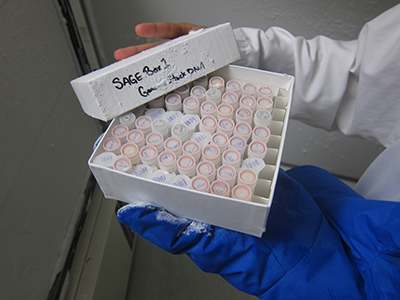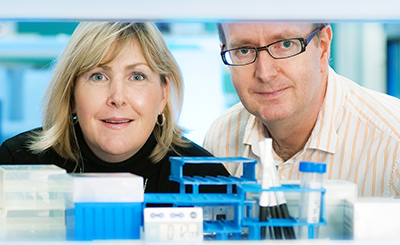In the basement of St. Paul’s Hospital, on freezer shelves chilled to -80 C., sit thousands of frost-covered vials. Inside those plastic containers is blood, or just blood components, donated by children and their parents in B.C. and Manitoba over a period of 15 years.
Those samples will now be put to use in an ambitious attempt by UBC researchers to understand the link between parents’ smoking and their children’s asthma – and how the consequences might persist for two generations.
The study, led by Denise Daley, an Assistant Professor in the Department of Medicine, will scan the DNA from the blood samples, and compare those findings with data about the donors – whether the parents smoked, or whether the children were exposed to smoking in the womb or as babies.
Dr. Daley and her collaborators are looking for a type of genetic alteration known as methylation – in which a carbon and hydrogen compound latches onto a part of the DNA. That bonding can “turn on” and “turn off” gene expression, leading to significant changes in how that cell develops and functions.
Methylation has become the focus of a burgeoning new field of health research called epigenetics – the expression (or non-expression) of genes. Scientists are realizing that environmental factors, such as exposure to tobacco smoke, can affect whether genes are expressed.
A cascade of consequences
The connection between parents’ smoking and children’s asthma is already well established, but it’s a circumstantial connection, based on statistics about patterns of behaviour and illness. So even though smoking is a “risk factor” for asthma, it hasn’t proven to be a cause.
Dr. Daley’s team is pursuing the hypothesis that exposure to smoke causes changes in methylation patterns that, in turn, triggers a cascade of consequences leading to childhood asthma and possibly allergies.
In trying to prove that theory, they will try to identify where in the genome that methylation takes place, and what kind of cascade it triggers – in the hope that other scientists could then find a way to interrupt that cascade, long before symptoms even start to appear.
The first step in their plan, supported by a five-year, $1.5 million team grant from the Canadian Institutes of Health Research and Genome British Columbia, will involve treating about 7,000 blood samples with an enzyme that cuts the DNA where it’s not methylated.
“So that’s the signal we’re going to look for,” says Andrew Sandford, one of Dr. Daley’s co-investigators and an Associate Professor in the Department of Medicine.
5 million data points
Those samples will then be shipped to the Genome Innovation Centre at McGill University, where the DNA will be put through scanners that reveal the cuts – and by inference, reveal where methylation has taken place.
That data will then be analyzed by Dr. Daley and her team, which also includes Peter Pare, Professor in the Department of Pathology and Laboratory Medicine, and Michael Kobor, an Associate Professor in the Department of Medical Genetics. Using powerful computers, they will search for patterns and correlations. For example, does the DNA of smoke-exposed children exhibit methylation in many of the same places?
“With even just 1,000 people, you have 5 million data points in very short order,” Dr. Sandford says.
Once Dr. Daley has identified areas of methylation and correlations with smoking, asthma and allergies, Dr. Sandford will seek to identify what those areas of DNA instruct their host cells to do.
“What is that mechanism?” Dr. Daley says. “If we know it, we might be able to intervene, depending on the child’s genetic profile.”
Maybe that intervention would be a drug. More likely, it would be a variety of recommendations for the parent that would counteract or mute the effects of the turned-off gene – such as bringing a dog into the home, or getting the dog out of the home, depending on the child’s genotype. Other recommendations could touch on diet or physical activity.
“We may have very targeted environmental solutions that may be different based on what your genes are,” Dr. Daley says.
The power of a genetic profile
Of course, recommendations are only as good as the person who is supposed to follow them. Although warnings about smoking – and especially smoking while pregnant – have been enormously effective, some expectant mothers still do.
But if doctors can point to a child’s genetic profile while conveying the need to take certain steps, Dr. Daley believes the message might carry more weight.
“We’re not far from determining a child’s susceptibility,” she says. “If we can identify what types of gene-environment interactions they are susceptible to, then, working with the parents, we might be able to modify their environment.”
On a less hopeful note, the knowledge gained by this study might point to asthma’s endurance. Because methylation can be passed on to a person’s offspring, exposure to smoke, either pre-natally or in early childhood development, might also harm the person’s grandchildren.
“For us to reverse the exposure may take three generations,” she says. “Even if we get all expectant mothers, and mothers of newborns, to stop smoking today, it may be 40 years before we see an effect. We might need to re-adjust our expectations.”

